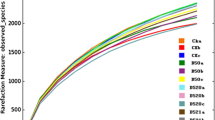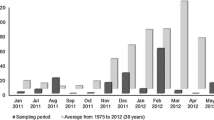Abstract
We have compared, using DNA analysis, the classical `pull and shake' method for sampling rhizosphere soil with a model rhizosphere system in which the soil was sampled at increasing distances (0.5 mm) from the root mat of Brassica napus. These studies showed that more DNA was extracted from the soil slices closest to the roots. Whilst the gradient in DNA recovered cannot be attributed solely to differences in microbial biomass, it clearly illustrates the lack of spatial resolution characteristic of the `pull and shake' method of sampling from the rhizosphere. The DNA-rich fraction (rhizosphere soil) was compared with bulk soil DNA by PCR using actinomycete 16S rDNA primers and 16S rDNA sequencing. Phylogenetic analyses of 16S rDNA sequences showed that these primers were not specific for actinomycetes but also amplified Gram positive low G+C bacterial sequences. Comparative 16S rDNA analysis of these sequences showed an enrichment for Gram positive low G+C bacteria in the rhizosphere of Brassica napus.
Similar content being viewed by others
References
Altschul S F, Gish W, Miller W, Myers E W and Lipman D L 1990 Basic local alignment search tool. J. Mol. Biol. 215, 403–410.
Bazin M J, Markham P, Scott E M and Lynch J M 1990 Populations dynamics and rhizosphere interactions. In The Rhizosphere, Ed. J M Lynch. pp 32–64. Wiley-Interscience, Chichester.
Borneman J and Triplett E W 1997 Molecular microbial diversity in soils from Eastern Amazonia: evidence for unusual microorganisms and microbial population shifts associated with deforestation. Appl. Environ. Microbiol 63, 2647–2653.
Borneman J, Skroch P W, O'sullivan K M, Palus J A, Rumjanek N G, Jansen J L, Nienhuis J and Triplett E W 1996 Molecular microbial diversity of an agricultural soil in Wisconsin. Appl. Environ. Microbiol. 62, 1935–1943.
Brosius J, Palmer M L, Kennedy P J and Noller H F 1978 Complete nucleotide sequence of a 16S ribosomal gene from Escherichia coli. Proc. Natl. Acad. Sci. USA 75, 4801–4805.
Campbell R and Greaves M P 1990 Anatomy and community structure of the rhizosphere. In: The Rhizosphere. Ed. J M Lynch. pp 11–34. Wiley-Interscience, Chichester.
Darrah P R 1991 Models of the rhizosphere. Plant Soil 133, 187–199.
Duineveld B M, Rosado A S, vanElsas J D and van Veen 1998 Analysis of the dynamics of bacterial communities in the rhizosphere of the chrysanthemum via denaturing gradient gel electrophoresis and substrate utilisation patterns. Appl. Environ. Microbiol. 64, 4950–4957.
Embley T M 1991 The linear PCR reaction: a simple and robust method for sequencing amplified rRNA genes. Lett. Appl. Microbiol. 13, 171–174.
Felsenstein J 1985 Confidence limits on phylogenies, an approach using the bootstrap. Evolution 39, 783–791.
Felske A 1999 Reviewing the DA001-files: a 16S rRNA chase on suspect #X99967, a Bacillus and Dutch underground activist. J Microbiol Methods 36, 77–93.
Felske A, Rheims H, Wolterink A, Stackebrandt E and Akkermans A D L 1997 Ribosome analysis reveals prominent activity of an uncultured member of the class Actinobacteria in grassland soils. Microbiology 143, 2983–2989.
Gahoonia T S and Nielsen NE 1991 A method to study rhizosphere processes in thin soil layers of different proximity to roots. Plant Soil 135, 143–146.
Galtier N and Gouy N 1995 Inferring phylogenies from sequences of unequal base composition. Proc. Natl. Acad. Sci. USA 92, 11317–11321.
Head I M, Saunders J R and Pickup R W 1998 Microbial evolution, diversity and ecology: a decade of ribosomal RNA analysis of uncultivated microorganisms. Microb. Ecol. 35, 1–21.
Katznelson H, Lochhead A G and Timonin M I 1948 Soil microorganisms and the rhizosphere. Bot. Rev. 15, 543–587.
Lane D J, Pace B, Olsen G J, Stahl D A, Sogin M L and Pace N R 1985 Rapid determination of 16S ribosomal RNA sequences for phylogenetic analyses. Proc. Natl. Acad. Sci. USA 82, 6955–6959.
Macrae A 2000 The use of 16S rDNA methods in soil microbial ecology. Braz. J. Microbiol 31, 77–82.
Macrae A, Rimmer D L and O'Donnell A G 2000 Novel bacterial diversity recovered from the rhizosphere of oilseed rape (Brassica napus) determined by the analysis of 16S ribosomal DNA. Antonie Van Leeuwenhoek Int. J. Gen. Microbiol. 78(1), 13–21.
Maidak B L, Cole J R, Parker C T, Garrity G M, Larsen N, Li B, Lilburn T G, McCaughey M J, Olsen G J, Overbeek R, Pramanik S, Schmidt T M, Tiedje J M and Woese C R 1999 A new version of the RDP (Ribosomal Database Project). Nucleic Acids Res. 27, 171–173.
Marrilley L and Aragno M 1999 Phylogenetic diversity of bacterial communities differing in degree of proximity of Lolium perenne and Trifolium repens roots. Appl. Soil Ecol. 13 (2), 127–136.
McCaig A E, Glover L A and Prosser J I 1999 Molecular analysis of bacterial community structure and diversity in unimproved and improved upland grass pastures. Appl. Environ. Microbiol. 65, 1753–1761.
McDowell D G, Burns N A and Parkes H C 1998 Localised sequence regions possessing high melting temperatures prevent the amplification of a DNA mimic in competitive PCR. Nucleic Acids Res. 26(14), 3340–3347.
McVeigh H P, Munro J and Embley T M 1996 Molecular evidence for the presence of novel actinomycete lineages in a temperate forest soil. J. Indust. Microbiol. 17, 197–204.
Mitsui H, Gorlach K, Lee H-J, Hattori R and Hattori T 1997 Incubation time and media requirements of culturable bacteria from different phylogenetic groups. J. Microbiol. Meth. 30, 103–110.
Nusslein K and Tiedje J M 1998 Charcterisation of the dominant and rare members of a young hawaiian soil with small-subunit ribosomal DNA amplified from DNA fractionated on the basis of its guanine and cytosine composition. Appl. Environ. Microb. 64, 1283–1289.
Polz M F and Cavanaugh C M 1998 Bias in template-to-product ratios in multitemplate PCR. Appl Environ. Microb. 64: (10) 3724–3740.
Saitou N and Nei M 1987 The neighbour joining method: a new method for constructing phylogenetic trees. Mol. Biol. Evol. 6, 514–525.
Stackebrandt E, LiesackWand Goebel BM 1993 Bacterial diversity in a soil sample from a subtropical Australian environment as determined by 16S rDNA analysis. FASEB J. 7, 232–236.
Steffan R J, Goksoyr J, Bej A K and Atlas R M 1988 Recovery of DNA from soils and sediments. Appl. Environ. Microb. 54, 2908–2915.
Thomson J D, Higgins G D and Gibson T J 1994 CLUSTAL W: improving the sensitivity of progressive multiple sequence alignment through sequence weighting, positions-specific gap penalties and weight matrix choice. Nucleic Acids Res. 22, 4673–4680.
Van de Peer Y and De Wachter R 1993 TREECON: a software package for the construction and drawing of evolutionary trees. J. Mol. Evol. 30, 463–476.
Wagner A, Blackstone N, Cartwright P, Dick M, Misof B, Snow P, Wagner G P, Bartels J, Murtha M and Pendelton J 1994 Surveys of gene families using polymerase chain reaction: PCR selection and PCR drift. Syst. Biol. 43, 250–261.
Wipat A and Harwood C R 1999 The Bacillus subtilis genome sequence: the molecular blueprint of a soil bacterium. FEMS Microbiol. Ecol. 28, 1–9.
Author information
Authors and Affiliations
Rights and permissions
About this article
Cite this article
Macrae, A., Lucon, C.M., Rimmer, D.L. et al. Sampling DNA from the rhizosphere of Brassica napus to investigate rhizobacterial community structure. Plant and Soil 233, 223–230 (2001). https://doi.org/10.1023/A:1010397304969
Issue Date:
DOI: https://doi.org/10.1023/A:1010397304969




